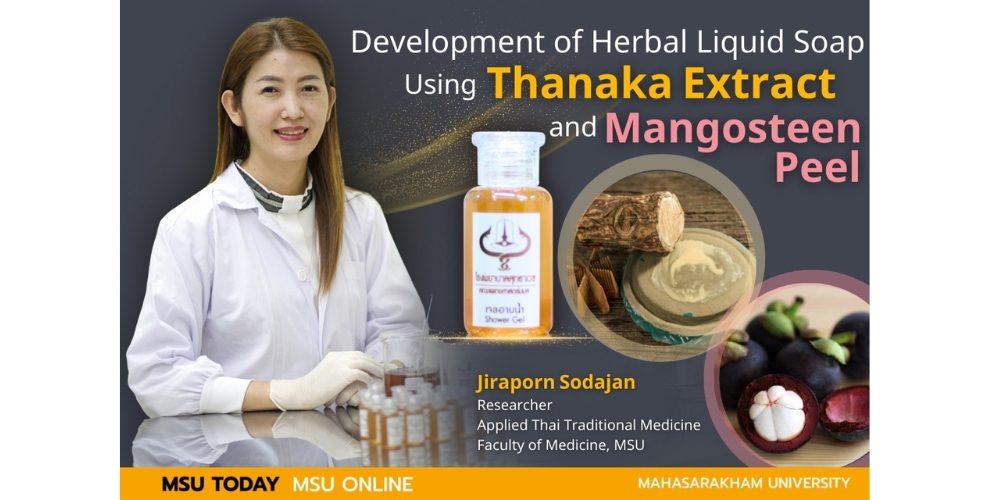Development of Herbal Liquid Soap Using Thanaka and Mangosteen Peel Extracts
Nowadays, people are paying much more attention to health than in the past. Choosing to consume products that benefit the body has become one of the key factors influencing the quality of life and daily well-being. Health products, such as organic foods, sugar-free beverages, or body care products made from natural ingredients, are excellent choices for us today. Not only do they help promote good health, but they also reflect a lifestyle that values self-care and environmental sustainability for the future.
Many of you have likely started to show interest in products that are friendly to both health and the environment, right? The development of natural products has become a major trend in the beauty and skincare industries. Herbal liquid soap is another option that contains natural extracts and is gaining popularity among consumers seeking safe and sustainable alternatives.

Did you know that the peel of mangosteen, a delicious fruit beloved by Thais, can be used for various purposes? What are its benefits? And what properties does Thanaka extract possess? When these two elements are combined, what results can we expect?
MSU invites everyone to explore the development of an innovative formula for herbal liquid soap using Thanaka and mangosteen peel extracts. This project is under the guidance of Ms. Jiraporn Sodajan, a researcher affiliated with the Applied Thai Traditional Medicine division of the Faculty of Medicine, Mahasarakham University.
Research Project Title: Development of Herbal Liquid Soap Formula Using Thanaka and Mangosteen Peel Extracts
Principal Investigator: Jiraporn Sodajan
Research Project Advisor: Assoc. Prof. Ampa Konsue

Background
Herbal-based cosmetic products are growing in popularity and are widely used in the present day. Thanaka is one such herb that has been processed into various products, including facial powder, skincare creams, and body cleansing products like liquid soap. Thanaka has been used by the people of Myanmar for over 1,000 years for skincare. It exhibits antioxidant properties and inhibits tyrosinase enzyme activity, contributing to skin whitening.
Similarly, mangosteen is another noteworthy herb that has been developed into various products. Mangosteen pulp contains catechins and flavonoids with antioxidant properties, though less potent than the xanthones found in its peel. Mangosteen peel is particularly valued for its strong antioxidant benefits.
Thanaka is considered the symbolic tree of the Faculty of Medicine at Mahasarakham University. Its scientific name is Hesperethusa crenulata (Roxb.) Roem., with a synonym Naringi crenulata (Roxb.) Nicolson. Currently, the Herbal Medicine and Product Manufacturing Unit at the Faculty of Medicine is dedicated to developing herbal products to enhance their value and create unique offerings specifically for Suddhavej Hospital.
One of the products of interest is herbal liquid soap made from Thanaka and mangosteen peel extracts. The researcher aims to develop a formula for herbal liquid soap that controls microbial and heavy metal content while ensuring product stability. The research also evaluates the antioxidant activity using the 2,2-diphenyl-1-picrylhydrazyl (DPPH) radical scavenging assay and tyrosinase enzyme inhibition activity in the herbal liquid soap formulation. This work aims to further integrate these findings into routine applications in the future.

What was the Inspiration for this Research?
The inspiration for this research stemmed from a proposal by the executive committee to create a unique product representing MSU’s Faculty of Medicine. Currently, the Herbal Medicine and Product Manufacturing Unit produces liquid soap made from Thanaka extract for use in private patient rooms at Suddhavej Hospital. This served as motivation to enhance the existing formula by incorporating mangosteen peel extract to boost its efficacy. Additionally, since mangosteen peel is a raw material that is typically discarded after consumption, it provides an opportunity to increase its value through innovative development.

What Makes the Properties of These Herbs Special? Why Were These Two Chosen for Soap Extraction?
Thanaka has long been widely used in Myanmar, such as in Burmese facial powders, before gaining popularity in Thailand. Additionally, the tree known as Pha-ya-ya or Thanaka is the symbolic tree of the Faculty of Medicine, making it a meaningful and representative ingredient.
As for mangosteen peel extract. there has been extensive research demonstrating its effectiveness in inhibiting Propionibacterium acnes and Staphylococcus aureus, bacteria responsible for causing acne. Mangosteen peel is also readily available in local markets as a byproduct of fruit consumption, making it an ideal raw material to repurpose and add value.

What biological properties of extracts from Tanaka and mangosteen peel influence the effectiveness of liquid soap, such as antibacterial activity, anti-inflammatory effects, or skin restoration?
Thanaka extract contains marmesin, a compound that plays a role in filtering ultraviolet radiation. Thanaka also has a high content of antioxidants, which effectively reduce cell degeneration. Additionally, it inhibits the activity of the enzyme tyrosinase, which is involved in melanin synthesis by converting the precursor tyrosine into melanin. Another compound found in Thanaka is arbutin, which suppresses melanin production. Melanin is the primary cause of skin conditions such as freckles, dark spots, and hyperpigmentation. These compounds collectively contribute to the effective nourishment of the skin.
Furthermore, Thanaka contains coumarin, an organic compound that imparts a soft, pleasant aroma and is commonly found in the bark of various plants. Coumarin is also used in pharmacology as a precursor for synthesizing anticoagulants. Additionally, coumarin derivatives have anti-inflammatory and antioxidant properties.

Scientific research has found that mangosteen pulp contains catechins and flavonoids, which exhibit antioxidant properties, though to a lesser extent than mangosteen peel, which contains xanthones.
Currently, there is development in using mangosteen pulp mixed with mangosteen peel, focusing on antioxidant benefits. Sawadi Podjananukit and Somjai Khajorncheepanungam (2010) conducted tests on the inhibition of Propionibacterium acnes and Staphylococcus aureus using extracts from three herbal plants: mangosteen peel, turmeric, and gotu kola leaves. The plants were extracted, and the active compounds were analyzed using high-performance liquid chromatography (HPLC). The results showed that xanthones could be extracted from mangosteen peel at 1.1929 mg/g, curcumin from turmeric at 0.8753 mg/g, and asiaticoside and asiatic acid from gotu kola at 0.0142 and 0.0960 mg/g, respectively.
The inhibition zone of the mangosteen peel extract was found to be larger than those of the turmeric and gotu kola extracts at the same concentration. Minimum Inhibitory Concentration (MIC) testing showed that the concentrations needed to inhibit Propionibacterium acnes for the mangosteen peel, turmeric, and gotu kola were 12.5, 25, and 200 mg/ml, respectively, and for Staphylococcus aureus, 6.25, 12.5, and 200 mg/ml, respectively. The Minimum Bactericidal Concentration (MBC) values for the same bacteria were 25, 50, and 200 mg/ml for Propionibacterium acnes and 12.5, 25, and 200 mg/ml for Staphylococcus aureus.
When comparing the antibacterial effects of the three plant extracts, the mangosteen peel extract required the lowest concentration (25 mg/ml) to inhibit both bacterial strains.

How does liquid soap made from Thanaka and mangosteen peel extracts compare to liquid soap with synthetic ingredients or other herbal products?
The effectiveness has not yet been tested against other herbal liquid soaps available on the market. This is expected to be part of the next research project.
Which method of extracting compounds from Thanaka and mangosteen peel can best and most suitably preserve the active properties?
Since the active compounds are substances in a group with specific properties, the boiling extraction method using water was chosen. The extraction method using alcohol was not selected due to the risk of alcohol contamination in the product, in order to prevent allergic reactions to alcohol in some users. Additionally, the boiling extraction method using water has a lower extraction cost compared to alcohol extraction.

How satisfied are users with the effectiveness, scent, color, and texture of this liquid soap formula?
This has not yet been tested in this research. It will be tested in the next phase of the study.
How does the budget for producing this herbal liquid soap compare to regular liquid soaps available in the market, and is it worth the investment?
The cost of producing 200 ml of herbal liquid soap is 10 baht, excluding the cost of packaging. The cost of the bottle and label depends on the packaging choice. For a regular bottle, the price is around 20 baht, making the total cost approximately 30 baht. The price of 200 ml of herbal liquid soap in the market is about 50-120 baht per bottle.
Obstacles or Problems Encountered During the Research
Collecting mangosteen peel, as it is a seasonal fruit, requires calculating the necessary amount for extraction to ensure sufficient production for the entire year.

Features and Highlights of the Research
The research involves utilizing local herbs to add value and developing unique herbs from the Faculty of Medicine, MSU, into a liquid soap product for skin care and treatment.
Future Plans for Research Development
The research will continue to evaluate user satisfaction regarding color and scent, test for skin allergies, and compare the efficacy with other products available in the market.
ข่าวภาษาไทย (Thai article): https://news.msu.ac.th/msumagaz/smain/readpost.php?mid=638



Leave a Reply